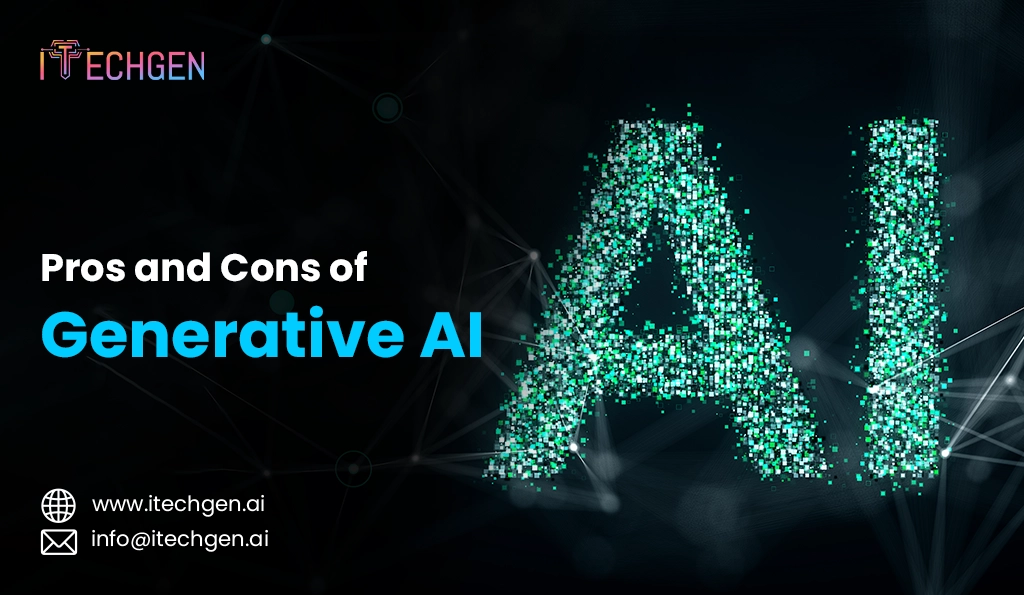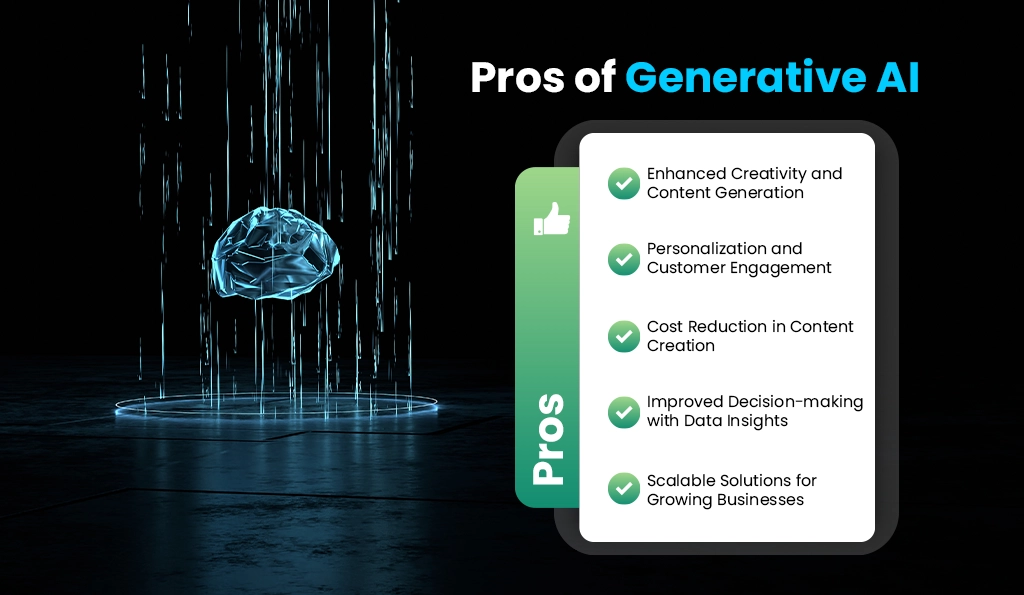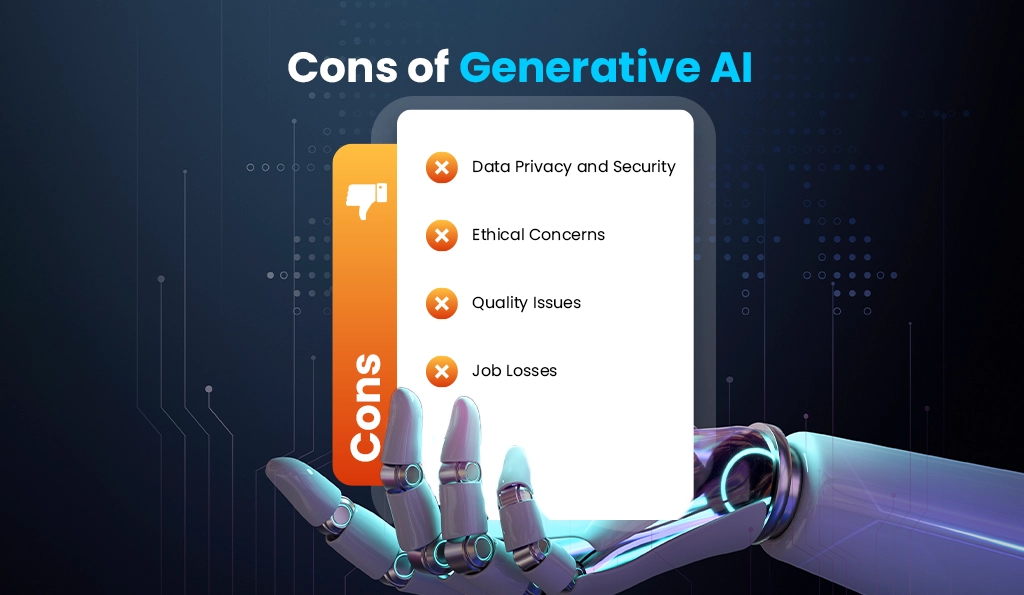
“Generative AI has the potential to transform the way we interact with machines and make them more human-like” ~ Sam Altman
Humans have been excellent at doing any task, however, doing everything at scale is what Generative AI excels at. The generative AI has given us numerous tools to make our jobs easier and faster. Whether it is ChatGPT or Codex, demanding tasks like coding and textual conversations have been simplified. Unarguably, Generative AI has revolutionized work environments, bringing a substantial amount of change in productivity and efficiency.
Don’t believe us? Let the eye-opening statistics speak for Generative AI and its continuous impact:
But is it all rainbows and no rains in the world of Generative AI? While it opens opportunities for creativity and efficiency, it also raises several concerns about ethical misuse, misinformation, and more.
In this blog, we will explore the pros and cons of Generative AI and how can businesses adopt a balanced approach to leverage this technology in the best possible way.
Generative AI is a subset of artificial intelligence, that essentially learns a pattern and then uses it to generate new content, such as text, images, or music. It utilizes smart machine-learning algorithms that analyze, and learn patterns, structures, and relationships found in existing data. Based on these learnings, generative AI tools, like ChatGPT, then generate fresh content when given the prompts. It would be unfair to say that generative AI imitates human content; instead, it generates entirely new results that appear realistic and original.
So, how does generative AI work?
Also Read: The Cost of Implementing AI in Healthcare
It uses GANs (Generative Adversarial Networks) and transformers, which allow it to create high-quality results. Generative AI is widely used across many fields, like writing scripts, creating real virtual environments, and designing marketing content. It is also used to assist medical research by generating synthetic data.

The key reason why companies are embracing Generative AI because it is able to innovate by automating creative tasks. This, therefore, helps businesses save time and improve efficiency. It is used across a broad range of industries – healthcare, marketing, entertainment and so forth. Here are the key benefits that businesses reap by using generative AI:
Generation AI improves creativity by generating new content, such as text, image, video, and music. Tools like ChatGPT are now being used by businesses and professionals to write articles and scripts, writing lyrics and coding to create programs that build applications. Such generative AI tools help create content faster and make it more accessible for all. Moreover, automating the tasks of content creation helps save time and manual effort.
Various industries are finding Generative AI useful, from marketing and entertainment to education and design. It enables them to focus on innovation while managing repetitive tasks, leading to more efficient and personalized content generation. This in turn opens new opportunities for creativity and growth.
Modern customers prefer personalized content. Whether they are shopping online or looking for newsletter subscriptions, they are looking for personalized content. Hence, personalization has become the key to engaging and retaining customers. This is where generative AI has taken over. Generative AI tools like Bard and ChatGPT have made it easier for businesses to produce personalized content effortlessly.
An example of this would be many more businesses that are integrating chatbots to deliver personal answers to customer questions.
It will aid businesses to deliver specific audience based content, personalized for their specific audiences and hence highly likely to stimulate interest and drive sharing in their communities. The use of Generative AI to deliver the customized content is assisting companies to deepen the connections with their customers.
Generative AI is a powerful tool that simplifies processes and helps businesses save money, improving their bottom line. It automates the creation of written content, graphics, and even code snippets. Research reveals that language models and AI automation tools can fasten nearly 20% of tasks for workers. This automation decreases dependency on manual labor, helping businesses save on time and labor costs for repetitive and time-consuming tasks.
Further, generative AI optimizes the design process, which reduces waste and improves the utilization of resources. While the use of Generative AI in R&D is not widely popular, research shows it can boost productivity, saving 10-15% of R&D costs. The marketing teams can also leverage generative AI to personalize content at scale, increasing customer engagement and conversion rates. McKinsey estimates that using generative AI can increase the productivity of marketers, saving 5% to 15% of the marketing budget.
Generative AI helps businesses make better decisions by quickly analyzing a large amount of data. It identifies patterns, trends, and relationships that humans might miss. Using these insights, businesses can predict customer behavior, market trends, or operational risks more effectively. For example, generative AI can create detailed reports or visualizations to simplify complex information, allowing business leaders to act confidently and strategically.
This technology can also generate potential outcomes by analyzing historical data through scenario analysis. This helps businesses to plan for their future better. In industries like healthcare, finance, and retail, generative AI boosts decision-making by providing real-time recommendations tailored to specific goals.
Thus, by converting raw data into actionable insights, generative AI empowers businesses to optimize operations, minimize risks, and seize opportunities, ultimately driving smarter and faster decisions.
Growth is an important aspect of any business. Generative AI backs growing businesses by adapting to their evolving needs and offering scalable solutions. AI tools can handle increasing demands without the need for additional resources. This technology, for example, can quickly create large amounts of marketing content, personalized emails, or product descriptions to meet business needs. Whether it’s managing customer interactions or generating creative content, this AI technology provides flexible solutions that grow with the business, making it a crucial tool for sustainable growth.

As beneficial generative AI, it still presents numerous challenges for businesses. Here are some cons of generative AI:
Handling sensitive data is one of the major challenges of adopting generative AI. As you know, generative AI relies on data to generate new content, but this might include sensitive or confidential information. When AI models use such sensitive data, there’s a huge risk of privacy breaches. This might lead to concerns of data misuse.
There has been an increase in the incidents of people using AI to misuse Celebrity pictures and defame them. This is one of the many examples of how generative AI can cause data privacy and security issues. To address these concerns, it is important to focus on data encryption, set up access controls, and follow data protection regulations. Transparency plays an important role in dealing with generative AI challenges. Being clear about how data is used and getting the consent of users are important for maintaining data privacy.
Generative AI has immense potential for creating creative content, where ethical challenges may arise. Such systems can unintentionally reproduce biases or stereotypes present in the data. This can lead to harmful or unfair outcomes, such as mislead content or biased hiring practices. Additionally, as mentioned before, this technology can be used on creating deepfakes -fake videos or images which seem real that can be harmful if misused to spread fake news.
There are also issues of intellectual property to consider, since AI can create content similar to already existing; content, resulting in ownership and copyright issues. As generative AI continues to grow, addressing these ethical concerns is important to ensure it is used responsibly and fairly.
Content generated by AI tools are not 100% reliable and accurate. This can be particularly critical when used in healthcare and legal services. For example, generative AI systems are used to generate pre-radiology reports based on medical imaging data. These reports help radiologists by providing quick analyses. Unfortunately, several incidents have reported errors, misinterpretations, or missed critical details, as compared to the reports generated by human radiologists.
To address these issues, it is important to test and validate AI models thoroughly. Ongoing monitoring and human validation can quickly spot and fix issues, reducing errors, and inaccuracies in important applications.
As Generative AI can automate tasks like writing, coding, designing, and customer support, it has led to increased concern of job losses. Organizations are replacing human labors with AI tools, like ChatGPT, to generate content and perform other tasks. According to various sources, AI could displace millions of jobs by 2030.
To address this challenge, businesses should focus on reskilling and upskilling their workforce. This will help employees transition into roles that complement AI rather than compete with it. Organizations must also create policies that promote AI-driven innovation while protecting workers through job retraining programs. This balanced approach can help reduce the risk of AI on employment while encouraging its responsible use.
Generative AI is changing the way humans work, interact, and create, introducing both new possibilities and important considerations. As businesses navigate its potential impact, they should explore the pros and cons of generative AI. And if they choose to embrace its possibilities, they must ensure to use it responsibly. As adopters of this transformative technology, businesses can play a vital role in ensuring Gen AI aligns with ethical principles seamlessly.

Pankaj Arora is the Founder & CEO of iTechGen, a visionary leader with a deep passion for AI and technology. With extensive industry experience, he shares expert insights through his blogs, helping businesses harness the power of AI to drive innovation and success. Committed to delivering customer-first solutions, Pankaj emphasizes quality and real-world impact in all his endeavors. When not leading iTechGen, he explores emerging technologies and inspires others with his thought leadership. Follow his blogs for actionable strategies to accelerate your digital transformation and business growth.
View More About Pankaj Arora